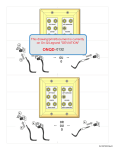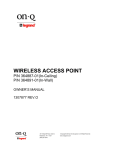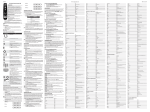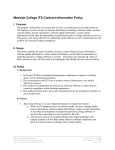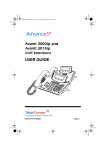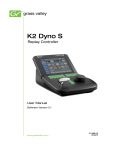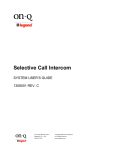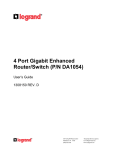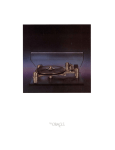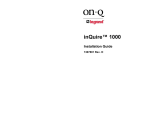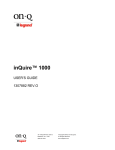Download Unity System Technical Manual
Transcript
Unity System Technical Manual Software Version 2.2.x P/N 1308112 Revision B www.legrand.us/onq VI. Unity User’s Guide This section describes the basic usage techniques to successfully navigate and enjoy a Unity System along with specific walkthroughs of the individual Unity functions. A. Basic Navigation: Right arrow indicator Left arrow indicator Softkeys Compass keys Power button Above is a description of the various buttons on the front of the Unity LCD Console. Each softkey corresponds to the tab shown directly above it in the display. Similarly, the compass keys correspond to the associated arrow indicators shown in the display. For instance, in this particular screen, the left and right compass keys would move the Icon Wheel to the left or right accordingly. To navigate throughout the Unity System, from the main screen shown above, use the Left and Right compass keys to spin the icon wheel, and then use the Talk/Select button to choose the desired function. Alternatively, use the softkeys to choose the shortcut to the desired function. The Home softkey will always bring the Unity system back to this main screen. Pressing the Home key a second time will center the Icon Wheel on the Intercom icon. The power button will put the current display into standby mode. The display will be automatically activate if it is ever the target of an intercom call (including an ALL call and/or Door Event). To prevent this, place the unit in standby then press the mute button. 301 Fulling Mill Road, Suite G Page 99 ©Copyright 2010 by Legrand, Middletown, PA 17057 Inc All Rights Reserved. (800)-321-2343 www.onqlegrand.com B. Unity Functions: The following is a list of walkthroughs on using each function of the Unity system. 1. Using the Intercom To enter the Intercom function, use the Left and Right compass keys until the Icon Wheel is over the Intercom Icon, and then press Talk/Select . A list of intercom units should be displayed. 301 Fulling Mill Road, Suite G Page 100 ©Copyright 2010 by Legrand, Middletown, PA 17057 Inc All Rights Reserved. (800)-321-2343 www.onqlegrand.com Basics As indicated on the display, the Up and Down compass keys will move the highlight box. To call an intercom unit, highlight that unit, then press and hold the Talk/Select button. The Unity Intercom is a ‘press and hold’ intercom. This means to make an intercom call, the Talk/Select button must be HELD when talking TO the highlighted unit. When the Talk/Select button is released, the highlighted unit will have a number of seconds (15 seconds by default, but adjustable in Settings -> Intercom) to respond in what is called ‘talk hands free’ mode. During this mode, the unit being CALLED may respond to the CALLER without any specific intercom interaction. After talk hands free mode times out, the intercom will return to the state it was in upon entering the intercom screen. An audible tone will sound to indicate the transition between the states mentioned above. A typical intercom conversation will go as follows: • • • • • • • User presses (and holds) Talk/Select A tone sounds to indicate it is OK to start talking User talks TO selected unit User releases Talk/Select A tone sounds to indicate transition to ‘talk hands free’ mode Selected unit has some number of seconds (15 seconds default) to talk BACK to caller A tone sounds to indicate end of conversation Monitor Pressing softkey 3 will place the unit into monitor mode. When a unit is in monitor all other units on the system will be able to hear it. Send Message Pressing softkey 4 from the intercom menu will open the messaging menu. 301 Fulling Mill Road, Suite G Page 101 ©Copyright 2010 by Legrand, Middletown, PA 17057 Inc All Rights Reserved. (800)-321-2343 www.onqlegrand.com From this menu, messages may be sent to one, many, or all other intercom units. For full information on sending messages, please refer to the Using Messages section of the Unity Users Guide. 301 Fulling Mill Road, Suite G Page 102 ©Copyright 2010 by Legrand, Middletown, PA 17057 Inc All Rights Reserved. (800)-321-2343 www.onqlegrand.com 2.Using the Player To enter the Player function, use the Left and Right compass keys until the Icon Wheel is over the Player Icon, and then press Talk/Select. The player menu should be displayed. The following sections describe the individual player sub menus. In general, the Up and Down compass keys are used to navigate the current menu, and Talk/Select is used to select the current menu item (either bringing up another sub menu, or redirecting to Now Playing). 301 Fulling Mill Road, Suite G Page 103 ©Copyright 2010 by Legrand, Middletown, PA 17057 Inc All Rights Reserved. (800)-321-2343 www.onqlegrand.com Playlists Selection chain: • • • Playlists – list of playlists. Specific playlist – list of songs on playlists. Song – leads to Now Playing Clicking Playlists will display all playlists that have been cataloged by the Unity system. Selecting a specific playlist from the list of playlists will display all songs on that playlist. Selecting a song from that playlist will play the song and lead to the Now Playing screen. Click Playlists List of playlists List of songs on playlist Songs 301 Fulling Mill Road, Suite G Page 104 ©Copyright 2010 by Legrand, Middletown, PA 17057 Inc All Rights Reserved. (800)-321-2343 www.onqlegrand.com Selection chain: • • Full Songs List Songs – list of songs. Specific song – leads to Now Playing. Clicking Songs will display a list of all songs cataloged by the Unity system. Clicking on an individual song will play that song and direct the display to the Now Playing screen. At any time (i.e. in any Player sub menu), softkey 3 will open up an alphabetic search window. The cursor keys and talk/select button operate the mini keypad. The search is incremental, meaning that any letter that is input will further narrow the search. To close the box, press softkey 3 again. The alphabetic search box will ONLY search in the current sub menu. For example, if the current sub menu is Songs, the alphabetic search box will narrow down the Songs list based on the characters input. If the current sub menu is Artists, only the Artist list will be narrowed down. It will still be necessary to select an artist to view Albums and Songs by that Artist. Alphabetic search 301 Fulling Mill Road, Suite G Page 105 ©Copyright 2010 by Legrand, Middletown, PA 17057 Inc All Rights Reserved. (800)-321-2343 www.onqlegrand.com Artists Artists Selection chain: • • • • Artists – list of artists. Specific artist – albums by artist. Album – songs on album. Song – leads to Now Playing. Clicking Artists will display a list of artists currently cataloged. Clicking a specific artist will display a list of Albums by that Artist. Clicking an album will display songs on that album. Clicking a song will lead to the Now Playing screen. Albums by artist Songs on album 301 Fulling Mill Road, Suite G Page 106 ©Copyright 2010 by Legrand, Middletown, PA 17057 Inc All Rights Reserved. (800)-321-2343 www.onqlegrand.com Albums Albums Selection chain: • • • Albums – list of albums. Specific album– songs on album Song – leads to Now Playing. Clicking albums will display the list of albums currently cataloged by the Unity System. Clicking a specific album will display the list of songs on that album. Clicking a song will lead to the Now Playing screen. Songs on album 301 Fulling Mill Road, Suite G Page 107 ©Copyright 2010 by Legrand, Middletown, PA 17057 Inc All Rights Reserved. (800)-321-2343 www.onqlegrand.com Genres Genres Selection chain: • • • • Genres – list of genres. Specific genre– albums in genre. Album – songs on album. Song – leads to Now Playing. Clicking on Genres will display the list of genres currently cataloged by the Unity system. Clicking on a specific genre will display a list of albums in that genre. Clicking on an album will display a list of songs on that album. Clicking on a song will lead to the Now Playing screen. Albums in genre Songs on album 301 Fulling Mill Road, Suite G Page 108 ©Copyright 2010 by Legrand, Middletown, PA 17057 Inc All Rights Reserved. (800)-321-2343 www.onqlegrand.com Now Playing The Now Playing screen displays the information for the current track. This information includes artist, song, album, and a time progress bar. The Up and Down compass keys will go to the previous and next song in the song list respectively (reference note below). Softkey 1 will return to the screen the GUI was at immediately before entering the Now Playing screen. Softkey 2 will cycle between Normal, Shuffle, and Loop modes for song order. Softkey 3 will stop the player. Softkey 4 will toggle pause/play for the player. NOTE: The player will continue to play through songs from a LIST using some play MODE. The play MODE is determined by softkey 2. The LIST is determined by where the song was selected from. For instance, if the song was selected through Artist -> Album -> Song then the LIST would contain all songs from that album by that artist. If the song was selected through Playlist -> Song then the LIST would contain all songs on that playlist. 301 Fulling Mill Road, Suite G Page 109 ©Copyright 2010 by Legrand, Middletown, PA 17057 Inc All Rights Reserved. (800)-321-2343 www.onqlegrand.com 3.Playing Music Basics Pressing Talk/Select on the Music icon will open the Unity Music menu. This menu is used to control all lyriQ functionality connected to the Unity system. The Unity Music menu contains 3 tabs if the current LCD Console has no add-on lyriQ capabilities or 4 tabs if the current LCD Console has add-on lyriQ capabilities. The tabs are described below. (Note: To navigate between tabs, use the Left and Right compass keys.) IMPORTANT: To see the 4 tabs (i.e. the FIRST tab shown below), two conditions must be met. First, the LCD Console must have add-on lyriQ support. This would be indicated by a small music note to the left of the volume light indicators. Second, the lyriQ zone built into the LCD Console must be associated with the Console in Setup -> Intercoms -> LCD Options. For more information on this association, refer to the Unity Setup information regarding LCD Consoles. The leftmost tab contains the add-on Lyriq information. This tab will only appear if the current LCD Console has built in Lyriq. The second tab contains a list of all Lyriq audio zones in the system, along with their status and control. 301 Fulling Mill Road, Suite G Page 110 ©Copyright 2010 by Legrand, Middletown, PA 17057 Inc All Rights Reserved. (800)-321-2343 www.onqlegrand.com The rightm most tab conttains a list of lyriQ audio scenes. From m this tab, new w scenes may be created or edited, and d existing scenes s may be b executed. The third tab contains a list of o sources a attached to the system. This tab is u used to switch h individual un nits to a spec cific source. Add-on ly yriQ tab The add-o on lyriQ scree en gives the user u the follow wing options. Softkey 1 willl toggle the lo ocal lyriQ add-on board on and off. Softk key 4 will togg gle the local lyyriQ add-on boards b Mute on o and off. So oftkeys 2 and 3 will adjust the e volume up and a down resp pectively. The e up and dow wn compass ke eys will adjusst the source of o the local add--on board. Page 111 301 Fulling Mill Road, Su uite G ©Co opyright 2010 by Legra and, Mid ddletown, PA 17057 Inc All A Rights Reserved. (80 00)-321-2343 www.onqlegrand.com By-Room tab The By Room Tab is used as a main control/status screen for any lyriQ unit connected to the system. Softkeys 1 and 4 control power and mute respectively, and the current status regarding these two buttons may be found in the Status column of the zone list. Softkeys 2 and 3 control the volume of the highlighted unit. The volume of a particular unit is indicated by both the number and colored bar in the Volume column of the zone list. Selecting a specific zone will give the following screen: From this screen the user can set a source, volume, and status for the selected unit. The Up and Down compass keys will change the highlighted section while the Left and Right compass keys will adjust the currently highlighted section. 301 Fulling Mill Road, Suite G Page 112 ©Copyright 2010 by Legrand, Middletown, PA 17057 Inc All Rights Reserved. (800)-321-2343 www.onqlegrand.com By Source tab The By Source Tab lists all sources available for lyriQ source selection. Clicking on a particular source will lead to a list of lyriQ zones connected to the system. From this screen the user may choose to switch one, many, or all zones to the selected source. Scenes tab The Scenes tab contains a list of all lyriQ Scenes in the Unity system. A scene may be executed to perform batch control operations for the lyriQ system. For instance, a scene named Party may contain the following commands: Turn on every lyriQ zone in the house except for the baby’s room, set all zone volumes to 35%, and set all zone sources to source 4 (which could be a CD Player, for instance). From the main Scenes tab the user may Rename, Delete, Create, or Edit a scene using softkeys 1-4 respectively. To create a new lyriQ scene, follow the procedure below. 301 Fulling Mill Road, Suite G Page 113 ©Copyright 2010 by Legrand, Middletown, PA 17057 Inc All Rights Reserved. (800)-321-2343 www.onqlegrand.com Clicking softkey 3 above will lead to a virtual keypad screen. Here the user may name the scene. The compass direction keys control the square highlight box while the Talk/Select key enters a letter. Pressing softkey 2 will delete a letter (backspace), while softkey 3 will toggle the keypad between upper and lower case letters. Once the name is entered, softkey 4 will accept the name and move on to the zone selection screen. At any time softkey 1 may be pressed to cancel the scene creation. Upon entering a name, the zone selection screen appears. This screen should be set up so that it reflects the exact desired state of the Lyriq system when the scene is executed. This means the user should do the following for each zone: • • Press softkey 2 to include or exclude the unit from the system. If a check is shown in the box to the right side of the highlight bar, that means the unit will be commanded to do something upon scene execution. Press Talk/Select over each included zone and set volume, source, and status accordingly. Once scene setup is completed, press softkey 4 to save all changes. Note: As an alternative to setting the state of each zone individually during scene creating, the user may put the Lyriq system in the desired state for the scene before creating the scene. When this screen appears, the state of the system will already be correct. The only necessary step in this case in the inclusion/exclusion of zones. 301 Fulling Mill Road, Suite G Page 114 ©Copyright 2010 by Legrand, Middletown, PA 17057 Inc All Rights Reserved. (800)-321-2343 www.onqlegrand.com 4.Creating Events Basics Pressing Talk/Select on the Events Icon will lead to the Unity Events menu. From this menu, Unity Events can be created. A Unity Event is composed of a series of actions the Unity system will perform, at some frequency, at some time in the future. For example, an event may be created to turn on the outside lights every day at sunset. This is only one example of a Unity event. Unity events may be set up for the following types of actions: • • • • • • Lighting Scene Music Scene Player Shuffle Player Function Play Message Send Message Up to four actions of the types listed above may be set to activate for a single Unity event. To create an event, follow the steps listed below. 301 Fulling Mill Road, Suite G Page 115 ©Copyright 2010 by Legrand, Middletown, PA 17057 Inc All Rights Reserved. (800)-321-2343 www.onqlegrand.com Press softkey 3 over an empty slot to create a new event. In the virtual keypad screen, type the name for the new event. Press softkey 4 to accept the name. Select the first time this event will happen. Use the compass Up/Down keys to adjust each field and the compass Left/Right keys to switch between fields. Press softkey 3 (Next) to continue. Choose the frequency this event will occur. For instance, a reminder for a specific task may only occur once, whereas a reminder to pay a bill may occur monthly. Press softkey 3 (Next) to continue. 301 Fulling Mill Road, Suite G Page 116 ©Copyright 2010 by Legrand, Middletown, PA 17057 Inc All Rights Reserved. (800)-321-2343 www.onqlegrand.com From this screen, actions are added to events. The Left and Right compass keys are used to select the action type while the Up and Down compass keys are used to move on to the next action. Once an action type is chosen, press softkey 3 (Next) to move on to the specific setup for the associated action type. The action types and their specific setup are described below. To choose the Audio Scene action type, use the Left and Right compass keys to navigate to ‘Audio Scene’ and press softkey 3 (Next). A list of all Audio Scenes currently in the Unity system will appear. Note: To use an Audio Scene for an action in a Unity Event, first the Audio Scene must be created under the Unity Music function. For instructions on how to do this, refer to the section labeled Unity Music Scenes. Choose the scene to associate with this action. This scene will be performed whenever the event triggers. Once selected, the action selection screen will be displayed again, this time with the appropriate audio scene listed to the right of the Audio Scene action type designator. 301 Fulling Mill Road, Suite G Page 117 ©Copyright 2010 by Legrand, Middletown, PA 17057 Inc All Rights Reserved. (800)-321-2343 www.onqlegrand.com To choose the player function action type, use the Left and Right compass keys until ‘Player Function’ shows in the highlight box and press softkey 3 (Next). Next, choose the song which will begin to play when this event triggers. For instructions on how to navigate through all Unity Player menus, refer to the Unity Player section. Pressing Talk/Select at the lowest level of a Player menu, in this case, will select the song for the event. The event will start the song playing on Source i in whichever play mode the Unity Player is currently in. The song name will now appear to the right of the Player Function action type designator. NOTE: After the initial song plays, all songs continue to play in list order. 301 Fulling Mill Road, Suite G Page 118 ©Copyright 2010 by Legrand, Middletown, PA 17057 Inc All Rights Reserved. (800)-321-2343 www.onqlegrand.com To choose the Lighting Scene action type, use the Left and Right compass keys until ‘Lighting Scene’ appears in the highlight box. Press softkey 3 (Next) to continue. Next will be displayed a list of all Unity Lighting Scenes currently in the system. Note: To choose a lighting scene for a Unity Event action, that scene must have already been created under Unity Lighting. For instructions on how to do so, refer to the Unity Lighting portion of the guide. Press Talk/Select to choose a lighting scene to associate with the action. Once a scene is chosen, the Unity Event action screen will be displayed again, this time with the chosen lighting scene displayed to the right of the Lighting Scene action type designator. 301 Fulling Mill Road, Suite G Page 119 ©Copyright 2010 by Legrand, Middletown, PA 17057 Inc All Rights Reserved. (800)-321-2343 www.onqlegrand.com To choose the Send Message action type, use the Left and Right compass keys until ‘Send Message’ appears in the highlighted box. A list of Unity Intercom units will appear on the screen. Use the Up and Down compass keys to select the unit(s) the message should go out to upon trigger of the event. Press the Talk/Select button to start recording the message. Press Talk/Select once more to finish recording the message and save it to the action. The action list will now appear again with the destination of the send message action listed to the right of the Send Message action designator. 301 Fulling Mill Road, Suite G Page 120 ©Copyright 2010 by Legrand, Middletown, PA 17057 Inc All Rights Reserved. (800)-321-2343 www.onqlegrand.com Pressing softkey 1 (Done) from the Event Action list at any point in the above procedure will finalize the event. The display will show the list of events with the newly created event at the end of the list. It is not necessary to have all 4 action slots in an event filled. An even may contain 1-4 events. The two event action types not discussed above are the Player Shuffle action type and the Play Message action type. The Player Shuffle action type is almost identical to the Player Function action type. The difference between the two comes when the event is triggered. When a Player Shuffle event is triggered, the Unity Player will play the selected song on Source i and automatically put the Player into shuffle mode. The Play Message action type is almost identical to the Send Message action type. The difference between the two comes when the event is triggered. The Play Message action type will play the message immediately, at the units designated during the event action setup. The Send Message action type will send the message to the units designated during the event action setup, but the message will not be played until the user initiates a play from one of those units. 301 Fulling Mill Road, Suite G Page 121 ©Copyright 2010 by Legrand, Middletown, PA 17057 Inc All Rights Reserved. (800)-321-2343 www.onqlegrand.com 5.Using the Thermostat Pressing Talk/Select while the icon wheel is over Thermostat will open the Unity Thermostat menu. This menu displays current temperature conditions and allows control of Unity compatible thermostats. 301 Fulling Mill Road, Suite G Page 122 ©Copyright 2010 by Legrand, Middletown, PA 17057 Inc All Rights Reserved. (800)-321-2343 www.onqlegrand.com The Unity Thermostat screen has two modes described below: Run mode displays the current temperature and outside temperature. It allows the user to change the heat and cool set points using the Up and Down compass keys. Softkey 1 will cycle between the connected thermostats. (Unity may have up to 3 connected thermostats.) Softkey 2 will toggle between Heat, Cool, and Auto. Softkey 3 will toggle the fan On and Off. Softkey 4 will put the thermostat in Hold mode. Hold mode displays the temperature and outside temperature like Run Mode. It also displays a set point and resume time. The Left and Right compass keys will cycle between regions in order: set point, month, day, year, hour minute. The Up and Down compass keys will adjust the current region. Softkeys 1-3 do the same as above. Softkey 4 will toggle the current thermostat back to Run Mode. 301 Fulling Mill Road, Suite G Page 123 ©Copyright 2010 by Legrand, Middletown, PA 17057 Inc All Rights Reserved. (800)-321-2343 www.onqlegrand.com 6.Using Lighting Pressing Talk/Select when the icon bar is over Lighting will open the Unity Lighting menu. From this menu, the user may control any RF Lighting units connected to the Unity system. Also from this menu, Lighting Scenes may be created and executed. The Lighting zones screen displays a list of all RF Lighting units and collections in the system. The Up and Down compass keys are used to navigate the list. The Left and Right compass keys will switch between the Zones and Scenes tabs at the top of the list. Softkey 1 and 2 are used to adjust the highlighted zone’s light level Down and Up respectively. Softkey 3 is used to toggle the highlighted zone On and Off. Softkey 4 is used to send the highlighted zone to a 100% value. 301 Fulling Mill Road, Suite G Page 124 ©Copyright 2010 by Legrand, Middletown, PA 17057 Inc All Rights Reserved. (800)-321-2343 www.onqlegrand.com Lighting Scenes The Lighting Scenes screen displays a list of scenes recorded in the Unity system. A Lighting Scene is a simple way to group together RF Lighting commands so they may be performed with a single button press. Pressing Talk/Select on any one of the scenes will execute the Lighting commands associated with that scene. Softkey 1 (Rename) will display a virtual keyboard allowing the user to rename the highlighted scene. Softkey 2 (Delete) will remove the highlighted scene from the system. Softkey 3 (Create) will start the process for creating a new Lighting Scene. For details on creating a new scene refer to the instructions below. Softkey 4 (Edit) is very similar to create however instead of making a new scene, the scene modifications will just be applied to the currently highlighted scene. 301 Fulling Mill Road, Suite G Page 125 ©Copyright 2010 by Legrand, Middletown, PA 17057 Inc All Rights Reserved. (800)-321-2343 www.onqlegrand.com Creating a Lighting Scene After pressing softkey 3 (Create) a virtual keypad will be displayed. Use the compass keys to enter a name for the scene. Softkey 4 will accept the name and advance to the zone inclusion screen. The next screen will show a list of Lighting Zones currently in the system. The Up and Down compass keys will navigate the zone list. Pressing Talk/Select over any one unit will toggle its inclusion in the scene. A check will appear in the box under ‘Include’ if the unit is to be included in the scene. The Left and Right compass keys will adjust the level of the highlighted unit for the scene. This will not affect the zones level in real time, it will only set the level to which the unit will ramp when the scene is triggered. Softkeys 3 and 4 will set the zone scene level to 0% and 100% respectively. When the scene is configured properly, pressing softkey 1 (Save) will save the scene to the system. The new scene will now be displayed in the Lighting Scenes list. 301 Fulling Mill Road, Suite G Page 126 ©Copyright 2010 by Legrand, Middletown, PA 17057 Inc All Rights Reserved. (800)-321-2343 www.onqlegrand.com 7.Using Cameras Pressing Talk/Select when the icon wheel is over Cameras will bring up the Unity Cameras screen. This screen contains live feeds of all cameras connected to the system (Note: The feeds are displayed one at a time). The softkeys in the camera screen switch between the camera feeds. If the Unity system is attached to no more than 4 cameras, softkeys 1-4 will switch to each of these four cameras respectively. If the Unity system is attached to more than 4 cameras the keys will be mapped as follows: Softkeys 1-3 are mapped to cameras 1-3 OR cameras 4-6. Softkey 4 is mapped to ‘More’ (as shown above) which toggles the mapping of softkeys 1-3. Camera sequencing: Pressing either the right or the left compass key will begin sequencing through the available cameras. The dwell between camera switching can be adjusted by pressing the up or down compass keys. To stop sequencing, the left or right keys may be pressed again, or any camera key may be pressed to switch to that camera and end sequencing. 301 Fulling Mill Road, Suite G Page 127 ©Copyright 2010 by Legrand, Middletown, PA 17057 Inc All Rights Reserved. (800)-321-2343 www.onqlegrand.com 8.Using Messages Pressing the Talk/Select button while the icon wheel is over Messages will open the Unity Messaging screen. This screen provides the ability to send messages to Unity Intercom units. To send a message, follow the procedure below. The main Messaging screen will display any messages the current unit has in its mailbox (this unit currently has none). Softkey 2 will send a new message. To record the message, press Talk/Select to start recording, begin speaking, and press Talk/Select a second time to stop recording. Pressing Talk/Select a third time will send the message. A list of all possible destinations will appear. The Up and Down compass keys can be used to navigate this list. The Talk/Select button will designate a destination for the message. Once the message has been sent, it will appear in the mailbox of all units that are part of the destination. Softkey 4 will play the message (also removing the NEW tag). Softkey 3 will delete the message. The small message indicator light on bottom right of the LCD Console will blink a pattern indicating the number of NEW messages in its mailbox. 301 Fulling Mill Road, Suite G Page 128 ©Copyright 2010 by Legrand, Middletown, PA 17057 Inc All Rights Reserved. (800)-321-2343 www.onqlegrand.com 9.Using Weather Pressing Talk/Select while the icon wheel is over Weather will bring up the Unity Weather screen. This screen gives an overview of current weather conditions and forecasts. The left pane shows the outside temperature, sky condition, daily low and high temperature, current wind speed and direction, chance of precipitation and daily sunrise and sunset times. The right pane gives an abbreviated five day forecast. Softkey 3 can be used to switch between Fahrenheit and Celsius. Softkey 4 can be used to set the location for which the weather will be reported. Refer to the instructions below for setting the location. Pressing softkey 4 (Location) will bring up a virtual keyboard. The location may be entered at this keyboard in one of two ways. Option 1 – by US zip code: Using the compass keys, enter the zip code for the desired region. If the region can be found, the region name will be displayed in the top right corner. If not, a notification will pop up stating so. Option 2 – by region name: Using the compass keys, enter the name of the desired region in the virtual keypad. For example, the current region above would be found by typing ‘beverly hills, ca’ into the virtual keyboard. Character case does not matter when typing in region names. (Note: for users located in Canada, names are to be typed in as <city>, Canada. For instance, for weather in Toronto, type in ‘toronto, canada’.) 301 Fulling Mill Road, Suite G Page 129 ©Copyright 2010 by Legrand, Middletown, PA 17057 Inc All Rights Reserved. (800)-321-2343 www.onqlegrand.com
































